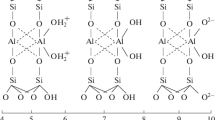Abstract
Exchange reactions of Na-montmorillonite with zirconyl chloride solutions give products with basal spacings near 18 Å which are stable to 500°C and have surface areas of the order of 300–400 m2/g. The Na ions are exchanged with tetrameric hydroxy cations [Zr4(OH)14•nH2O]2+. The high surface area is attributed to the porosity formed by stable zirconium oxide “pillars” formed by dehydroxylation of the complex cation. The nitrogen adsorption isotherms are of Langmuir type and are consistent with adsorption in interlayer micropores. Reduced-charge montmorillonites, formed by application of the Hofmann-Klemen procedure, give either similar or slightly smaller surface areas.
Резюме
Реаксий обмена Na-монтмориллонита с растворами цирконилового хлорида образуют продукты с основными промежутками около 18 Å, которые устойчивы при температуре до 500°С и имеют поверхностные площади порядка 300–400 м2/г. Ионы Na обмениваются с тетраметрическими окси-катионами [Zr4(OH)14•nH2O]2+. Большая поверхностная площадь относится за счет пористости, образуемой устойчивыми “столбиками” окиси циркония, формирующимися в результате дегидроксилирования комплексных катионов. Изотермы адсобций азота относятся к типу Лангмуира и согласуются с адсорбцией в межслойных микропорах. Монтмориллониты с пониженным зарядом, формирующиеся под воздействием процедуры Хофмана-Клемена, имеют или подобные или немного меньшие поверхности.
Resümee
Austauschreaktionen von Na-Montmorillonit mit Zirkoniumchloridlösungen ergeben Produkte mit Basisabständen von fast 18 Å, die bis 500°C beständig sind und Oberflächenmaße in der Gegend von 300–400 m2/g. Die Na Ionen werden mit tetrameren Hydroxylkationen [Zr4(OH)14•nH2O]2+ ausgetauscht. Die große Oberfläche wird der Porosität zugeschrieben, die von den stabilen Zirkoniumoxydsäulen stammt, welche durch Dehydroxylierung des komplexen Kation geformt wurden. Die Stickstofadsorptionsisothermen gehören zum Langmuirtyp und stimmen mit der Adsorption in den Zwischenschichtmikroporen überein. Montmorilloniten mit verminderter Ladung, welche durch Anwendung der Hofmann-Klemenmethode hergestellt wurden, geben entweder ähnliche oder etwas kleinere Oberflächen.
Résumé
Les réactions d’échange de montmorillonite-Na avec des solutions de chlorure de zirconyl donnent des produits avec des espacements de base d’à peu près 18 Å qui sont stables jusqu’à 500°C et qui ont des surfaces externes de l’ordre de 300–400 m2/g. Les ions de Na sont échangés avec des cations hydroxy tétramériques [Zr4(OH)14n•nH2O]2+. La grande étendue de la surface externe est attribuée à la porosité formée par les “pilliers” stables d’oxide de zirconium, eux-mèmes formés par la déshydroxylation du cation complex. Les isothermes d’adsorption de nitrogène sont du type Langmuir, et sont consistants avec l’adsorption dans les micro-pores interfeuillets. Les montmorillonites à charge réduite, formées par l’application du procédé Hofmann-Klemen, produisent des surfaces externes soit semblables, soit un peu plus petites.
Similar content being viewed by others
References
Bittel, R., Boursat, C. and Platzer, R. (1959) Étude de la fixation du zirconium par la montmorillonite acide: Bull. Groupe Fr. Argiles 11, 9–19.
Brindley, G. W. and Ertem, Gözen (1971) Preparation and solvation properties of some variable charge montmorillonites: Clays & Clay Minerais 19, 399–404.
Brindley, G. W. and Sempels, R. E. (1977) Preparation and properties of some hydroxy-aluminum beidellites; Clay Miner. 12, 229–237.
Clearfield, A. and Vaughan, Ph. A. (1956) The crystal structure of zirconyl chloride octahydrate and zirconyl bromide octahydrate: Acta Crystallogr. 9, 555–558.
Hofmann, U. and Klemen, R. (1950) Verlust der Austauschfähigkeit von Lithiumionen an Bentonit durch Erhitzung: Z. Anorg. Allg. Chem. 212, 95–99.
Jeffery, P. G. (1975) Chemical Methods of Rock Analysis 2nd edition: Chapter 50. Pergamon Press, Oxford.
Medlin, J. H., Suhr, N. H. and Bodkin, J. B. (1969) Atomicabsorption analysis of silicates employing LiBO2 fusion: At. Absorpt. Newsl. 8, 25–29.
Muha, J. M. and Vaughan, Ph. A. (1960) Structure of the complex ion in aqueous solutions of zirconyl and hafnyl oxyhalides: J. Chem. Phys. 33, 194–199.
Westerlund-Helmerson, U. (1966) The determination of chloride as silver chloride by atomic absorption spectroscopy: At. Absorpt. Newsl. 5, 97.
Yamanaka, S. and Brindley, G. W. (1978) Hydroxy-nickel interlayering in montmorillonite by titration method: Clays & Clay Minerais 26, 21–24.
Author information
Authors and Affiliations
Rights and permissions
About this article
Cite this article
Yamanaka, S., Brindley, G.W. High Surface Area Solids Obtained by Reaction of Montmorillonite with Zirconyl Chloride. Clays Clay Miner. 27, 119–124 (1979). https://doi.org/10.1346/CCMN.1979.0270207
Received:
Published:
Issue Date:
DOI: https://doi.org/10.1346/CCMN.1979.0270207




